239-643-4577
Mon-Sat: 11:30am-9:00pm
Open Sundays Jan-April
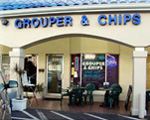

South Naples
338 9th St. N.
Naples, FL 34102
|
|
|
 |
| Types of Florida Grouper |
| Black Grouper
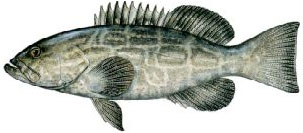
Family Serranidae, Sea basses and grouper
Mycteroperca bonaci
Description: Olive or gray body coloration with black blotches and brassy spots; gently rounded preopercle.
Similar fish: Gag, M. microlepis; yellowfin grouper, M. venenosa.
Where found: Offshore species; adults associated with rocky bottoms, reef, and drop off walls in water over 60 feet deep; young may occur inshore in shallow water.
Size: Common to 40 pounds, may attain weights exceeding 100 pounds.
Remarks: Spawns between May and August; protogynous hermaphrodites, young predominantly female, transforming into males as they grow larger; larger individuals generally in greater depths; feeds on fish and squid.
Culinary: Popular with southern chefs. The flesh is firm and sweet, and has a small bloodline. It is the most versatile in its class due to a high moisture and oil content, and denseness of flake. The flavor of these species is distinctive when compared to other grouper and finishes with a nice lobster and shrimp flavor due to the grouper's diet of shellfish.
|
| Gag

Family: Serranidae, Sea basses and grouper
Mycteroperca microlepis
Description: Brownish gray in color with dark worm-like markings on sides; strong serrated spur at bottom margin of preopercle, less noticeable in large specimens; fins dark, with anal and caudal having white margin. Often confused with black grouper; tail of gag is slightly concave, black is square; gag has white margin on anal and caudal fins, black does not; under 10 pounds, gag's spur on preopercle is distinctive, where black is gently rounded.
Similar fish: Black grouper, M. bonaci.
Where found: Adults offshore over rocks and reefs; juveniles occur in seagrass beds inshore. Size: common to 25 pounds.
Remarks: Most widely sold Florida grouper. Forms spawning aggregations in water no shallower than 120 feet in Middle Grounds area, January through March; current research to identify similar aggregations off Atlantic coast is ongoing. Young gags are predominantly female, transforming into males as they grow larger; feeds on fish and squid.
Culinary: Popular with southern chefs. The flesh is firm and sweet, and has a small bloodline. It is the most versatile in its class due to a high moisture and oil content, and denseness of flake. The flavor of these species is distinctive when compared to other grouper and finishes with a nice lobster and shrimp flavor due to the grouper's diet of shellfish.
|
| Scamp
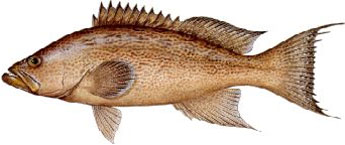
Family Serranidae, Sea basses and grouper
Mycteroperca phenax
Description: Color light gray or brown; large adults with elongated caudal-fin rays; reddish brown spots on sides that tend to be grouped into lines; some yellow around corners of mouth.
Similar fish: Yellowmouth grouper, M. interstitialis.
Where found: Near shore reefs off the northeastern coast, and on offshore reefs in the Gulf.
Size: Generally smaller than gags or blacks.
Remarks: Spawns in late spring; feeds on small fish, squid, and crustaceans; undergoes sex transformation from female to male as it becomes older.
|
| Yellowmouth Grouper
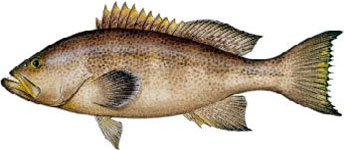
Family Serranidae, Sea basses and grouper
Mycteroperca interstitialis
Description: Color tan or brown with darker spots, or a network of spots, fused into lines; distinct yellow wash behind the jaws; yellow around the eyes; outer edges of fins yellowish.
Similar fish: Scamp, M. phenax.
Where found: Offshore over reefs and rocks; not as common as scamp in the Gulf; range limited to southern Florida.
Size: Common to 15 pounds.
Remarks: Undergoes sex reversal, young individuals are female, older individuals becoming male; young fish are bicolor, dark above white below; feeds on small fish and crustaceans.
|
| Yellowedge Grouper

Family Serranidae, Sea basses and grouper
Epinephelus flavolimbatus
Description: Distinguished by yellow margin on the dorsal fin.
Size: Can weigh up to 45 pounds.
Where found: Deep-water grouper commonly taken from depths exceeding 450 feet; caught with tilefish and snowy groupers.
|
| Misty Grouper and Snowy Grouper
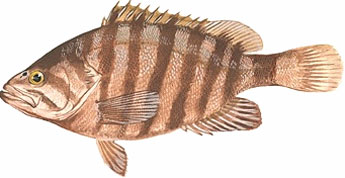
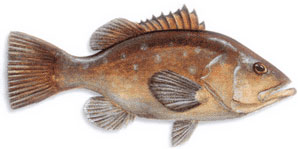
Description: Misty grouper has 8 or 9 regular darker brown bars on the side
Size: Can weigh between 5 and 235 pounds.
Where found: Two distinct deep-water grouper species, taken from depths exceeding 400 feet. Snowy grouper have been taken from waters exceeding 1,000 feet.
|
| Red Grouper

Family Serranidae, Sea basses and grouper
Epinephelus morio
Description: Color brownish red; lining of mouth scarlet-orange; blotches on sides in unorganized pattern; second spine of dorsal fin longer than others; pectoral fins longer than pelvic fins; squared off tail; margin of soft dorsal black with white at midfin; black dots around the eyes.
Similar fish: Nassau grouper, E. striatus.
Where found: Bottom-dwelling fish associated with hard bottom; juveniles offshore along with adults greater than 6 years old; fish from 1 to 6 years occupy near shore reefs.
Size: Common to 15 pounds.
Remarks: Spawns in April and May; prefer water temperatures between 66 and 77 degrees F; undergoes sex reversal, young individual females becoming males as they age; feeds on squid, crustaceans, and fish.
Culinary: Popular with southern chefs. The flesh is firm and sweet, and has a small bloodline. It is the most versatile in its class due to a high moisture and oil content, and denseness of flake. The flavor of these species is distinctive when compared to other grouper and finishes with a nice lobster and shrimp flavor due to the grouper's diet of shellfish.
Information provided by:
Florida Department of Agriculture and Consumer Services
Illustrations © Diane Rome Peebles.
|
|
|